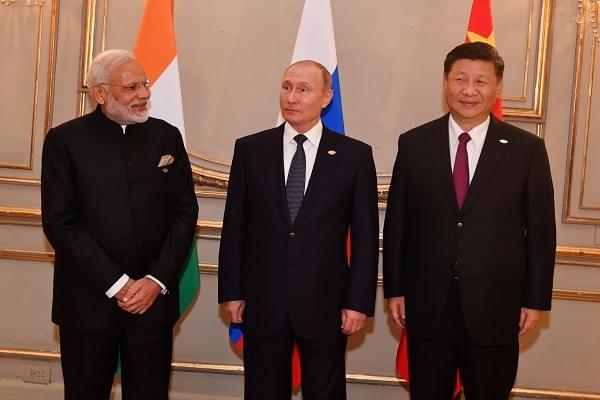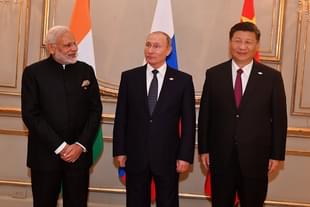Commentary
Ukraine Crisis May Invite Fresh Challenges As Well As Opportunities For India
Pratim Ranjan Bose
Feb 25, 2022, 11:03 PM | Updated 11:03 PM IST
Save & read from anywhere!
Bookmark stories for easy access on any device or the Swarajya app.


After the once in a century pandemic, world politics is now faced with the most significant development since World War II—Russia's open challenge to the US-led NATO alliance through invasion in Ukraine.
Prime Minister Narendra Modi kept India’s ship steady during the pandemic and laid the foundations for robust growth. Can he pull India out from the current crisis?
Apparently, the government saw the uncertainties coming, in whichever form it might be. In his post-Budget addresses to the Parliament and BJP workers, the Prime Minister cautioned that the post-Covid world order might change dramatically.
“I see clearly that after the Covid-19 pandemic, the world is quickly moving towards a new world order... India's voice should be bold at the main table. India should not sell itself short...” Modi told the Parliament.
The Prime Minister has been warning about potential ‘change’ for some time and he did not mention politics. However, his statement came barely a month after the meeting with Russian President Vladimir Putin. Apart from Modi, Putin met only the Chinese President Xi Jinping in recent months. Putin also proposed a trilateral summit with India and China.
In his discussion with Putin, over the telephone, after the invasion, the Prime Minister reportedly appealed to the Russian president to return to the path of dialogue and diplomatic negotiations. He had also sensitised Putin about India’s concerns.
Serious challenges
The concerns are too many. India staged one of the most dramatic economic recoveries in the pandemic-hit world and gave a serious push to its Make-in-India programme, to which Russia is a significant contributor. This is apart from India’s dependence on Russia for spares against previous purchases of military hardware.
From oil refining to BrahMos missiles and the recent decision to put up a factory in Uttar Pradesh to manufacture assault rifles, Russia has been a significant investor in India in recent times. From an importer of military hardware, India has recently graduated to an arms exporter. The Indo-Russian cooperation is required to keep the tempo up.
However, the US sanction can throw a spanner to the Indian dreams. In January this year, the Philippines signed a $375 million deal for BrahMos supersonic cruise missiles and was keen for a second order. Considering the US-Philippines security pact, the fate of the missile order became uncertain after Thursday’s development.
It is well known that the US sanction will give global inflation, which is already phenomenally high, a fresh push. Brent crude prices have already crossed $100 a barrel benchmark. Russia is the second-largest gas producer and roughly 30 percent of the natural gas consumed by Europe comes from Russia. Any tweak in supply and gas prices will go through the roof.
Food prices will be seriously hit by this disruption. Russia and Belarus are the world’s second and third largest producers of Potash. Russia and Ukraine are top producers of wheat.
While India is self-sufficient in food production and has been reducing the import requirement of fertiliser (two more plants started operations last year, two more are lined up for production), the spike in gas prices will increase fertiliser and food prices. India’s sunflower oil imports from Russia and Ukraine may also suffer.
As gas availability suffered, Europe shifted to coal for power generation last year. A good part of the fuel was sourced from Russia. Any disruption in Russian supply will trigger prices of fuel in Indonesia and South Africa. India depends on imported coal for captive power generation in cement, metals etc. Most of the fuel is sourced from these two destinations.
The challenges in terms of trade disruption and the spike in prices of fuel are not specific to India alone. On the contrary, India is less dependent on Russian resources. Europe will be the biggest sufferer. They have to scramble for resources. Blocking Russian money flow will impact their tattered economies.
That’s not all. Leaving France and the UK, Europe barely has military. Between 1989 and 2017, the estimated defence expenditure of NATO was down to nearly half at 2.43 of GDP. The defence expenditure of NATO Europe and Canada was 1.46 percent, well below the prescribed two percent.
According to a report in Express (UK) on March 25, 2021, German soldiers used broomsticks for machine guns at a NATO exercise in 2014. The incident reportedly took place when Ursula Gertrud von der Leyen, the incumbent president of the EU was the defence minister of Germany.
After the Russian invasion of Ukraine, Europe has to go for rapid militarisation and that will add more pressure to their weak economies, many of which piled up huge debt during the pandemic.
The USA will not escape the negative impacts either. Argus Media reported that the US steel industry will be hit as they source pig iron from the Black Sea region. The rise in energy prices will further push the US inflation which is already ruling at a 30-year high.
However, Joe Biden has to retaliate to keep his ratings high in domestic politics. The centrality of the dollar in the world economy and the resourcefulness of America are helping him to impose tough sanctions which may drag the Covid-hit world economy to a serious recession.
Whether Biden can ride through the mid-term poll by blaming Russia for the miseries is to be seen. But for India which has been growing at the fastest rate in the world and is witnessing a record inflow of FDI, any global downturn will be a major spoiler. Till January this year, India’s exports grew by over 23 percent. Can India maintain the tempo in 2022-23?
Sea of uncertainties
The Russia-China axis is challenging the American dream of a unipolar world. Through the demilitarisation of Ukraine, Russia has blocked NATO’s further expansion. Putin chose to strike when Europe has been weak. The problem is: it might not be the end of shock developments in the world.
The US is now in a bind. It has to act. Whatever it does will have a series of impacts. One such possibility is withdrawing sanctions on Iran to keep the oil market steady. It may not make OPEC happy. Meanwhile, Russia may turn up to China for selling resources. Stopping that would invite the collapse of the American economy.
It means willy-nilly China will be stronger. Knowing China’s expansionary strategies, any such possibilities will not augur well for India. More so if US sanctions hit its militarisation programme. It means India is also in a bind. There are definite problems in taking sides. The big question is: which side offers more promises.
The future will tell how India negotiated this challenge. Given the Prime Minister’s promises, one can expect Delhi to be cautiously optimistic.





